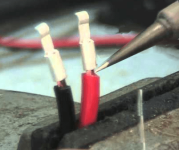kudos
10 kW
Does anyone else have the difficulty I do in making connectors for your ebike?
Anderson Connectors :
I started trying to crimp andersons with a normal universal crimper and the results were not good.
Proper anderson crimpers are not that easy to get hold of outside the US and are expensive, however, I shelled out for one and so now crimping is super easy and I'm glad I bought the tool.
http://www.powerwerx.com/powerpole-accessories/tricrimp-crimping-powerpole-contacts.html
..but then you have to insert the the crimped wire into the anderson housing. The first insertion requires a ludicrous amount of force.
The 45amp contacts simply cannot be inserted by hand, all that happens is you bend the wire where it connects to the spade. You have to use another tool of some sort to actually push the contact through and even then it's certainly not easy.
I ended up buying a powerpole insertion tool:
http://www.ebay.co.uk/itm/230956476196?ssPageName=STRK:MEWNX:IT&_trksid=p3984.m1439.l2649
Even then you have to ensure you leave a little space between the back of the connector and the cable outer casing otherwise you have nothing to push against.
JST Connectors
I need to swap the huge white connectors that come with the Mac controllers for jst 2.5 connectors. All the other controllers I have/see use the jst 2.5 exclusively and it would be nice if the Mac came this way too, I have asked Paul but no response as yet.
I initially thought that the JST pins would be soldered to the wires but as it turns out the JS in JST I believe stands for Japan Solderless ie you need to crimp the wires. The pins are very small and I didn't even want to attempt to try and crimp them with a standard crimper so once again shelled out for another crimp tool:
http://www.ebay.co.uk/itm/360713379136?ssPageName=STRK:MEWNX:IT&_trksid=p3984.m1439.l2649
However when I use this with the bigger gauge crimp section the jst pin doesn't actually get crimped to the wire, and if I use the smaller section then the pin gets jammed in the teeth of the crimper!
I seem to have to do a 3/4 crimp on the smaller section then try to release the ratchet stopper in order to get the teeth apart so I get get the pin out without breaking it.
I hate being beaten but does it have to be this difficult?
I could just buy the connectors with tails already attached and solder the wires but it's not as neat.
Anyone got any tips please?
Cheers,
Kudos
Anderson Connectors :
I started trying to crimp andersons with a normal universal crimper and the results were not good.
Proper anderson crimpers are not that easy to get hold of outside the US and are expensive, however, I shelled out for one and so now crimping is super easy and I'm glad I bought the tool.
http://www.powerwerx.com/powerpole-accessories/tricrimp-crimping-powerpole-contacts.html
..but then you have to insert the the crimped wire into the anderson housing. The first insertion requires a ludicrous amount of force.
The 45amp contacts simply cannot be inserted by hand, all that happens is you bend the wire where it connects to the spade. You have to use another tool of some sort to actually push the contact through and even then it's certainly not easy.
I ended up buying a powerpole insertion tool:
http://www.ebay.co.uk/itm/230956476196?ssPageName=STRK:MEWNX:IT&_trksid=p3984.m1439.l2649
Even then you have to ensure you leave a little space between the back of the connector and the cable outer casing otherwise you have nothing to push against.
JST Connectors
I need to swap the huge white connectors that come with the Mac controllers for jst 2.5 connectors. All the other controllers I have/see use the jst 2.5 exclusively and it would be nice if the Mac came this way too, I have asked Paul but no response as yet.
I initially thought that the JST pins would be soldered to the wires but as it turns out the JS in JST I believe stands for Japan Solderless ie you need to crimp the wires. The pins are very small and I didn't even want to attempt to try and crimp them with a standard crimper so once again shelled out for another crimp tool:
http://www.ebay.co.uk/itm/360713379136?ssPageName=STRK:MEWNX:IT&_trksid=p3984.m1439.l2649
However when I use this with the bigger gauge crimp section the jst pin doesn't actually get crimped to the wire, and if I use the smaller section then the pin gets jammed in the teeth of the crimper!
I seem to have to do a 3/4 crimp on the smaller section then try to release the ratchet stopper in order to get the teeth apart so I get get the pin out without breaking it.
I hate being beaten but does it have to be this difficult?
I could just buy the connectors with tails already attached and solder the wires but it's not as neat.
Anyone got any tips please?
Cheers,
Kudos



